人教版高中英语必修五unit1课文重点练习详解
- 格式:doc
- 大小:47.50 KB
- 文档页数:35
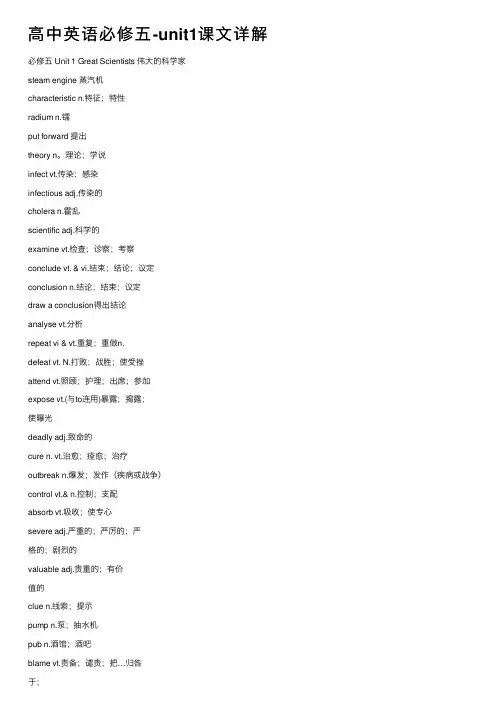
⾼中英语必修五-unit1课⽂详解必修五 Unit 1 Great Scientists 伟⼤的科学家steam engine 蒸汽机characteristic n.特征;特性radium n.镭put forward 提出theory n。
理论;学说infect vt.传染;感染infectious adj.传染的cholera n.霍乱scientific adj.科学的examine vt.检查;诊察;考察conclude vt. & vi.结束;结论;议定conclusion n.结论;结束;议定draw a conclusion得出结论analyse vt.分析repeat vi & vt.重复;重做n.defeat vt. N.打败;战胜;使受挫attend vt.照顾;护理;出席;参加expose vt.(与to连⽤)暴露;揭露;使曝光deadly adj.致命的cure n. vt.治愈;痊愈;治疗outbreak n.爆发;发作(疾病或战争)control vt.& n.控制;⽀配absorb vt.吸收;使专⼼severe adj.严重的;严厉的;严格的;剧烈的valuable adj.贵重的;有价值的clue n.线索;提⽰pump n.泵;抽⽔机pub n.酒馆;酒吧blame vt.责备;谴责;把…归咎于;n.过失;责备immediately adv.⽴即;马上handle n.柄;把⼿; vt.处理germ n.微⽣物;细菌addition n.加;增加;加法in addition也;另外link vt.连接;联系 n.联系;环link…to…将…和…连接或联系起来announce vt.宣布;通告certainty n.确知;确信;确实instruct vt.命令;指⽰;教导virus n.病毒construction n.建设;结构;建筑物apart from 除…之外;此外creative adj.有创造⼒的;独创的co-operative adj.合作的positive adj.积极的;肯定的be strict with对…严格的revolutionary adj.⾰命的calculation n.计算;计算结果lead to通向;导致movement n。
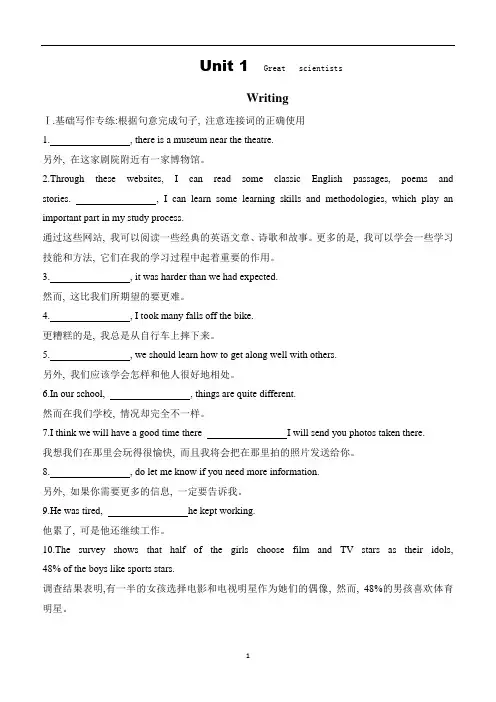
Unit 1Great scientistsWritingⅠ.基础写作专练:根据句意完成句子, 注意连接词的正确使用1., there is a museum near the theatre.另外, 在这家剧院附近有一家博物馆。
2.Through these websites, I can read some classic English passages, poems and stories. , I can learn some learning skills and methodologies, which play an important part in my study process.通过这些网站, 我可以阅读一些经典的英语文章、诗歌和故事。
更多的是, 我可以学会一些学习技能和方法, 它们在我的学习过程中起着重要的作用。
3., it was harder than we had expected.然而, 这比我们所期望的要更难。
4., I took many falls off the bike.更糟糕的是, 我总是从自行车上摔下来。
5., we should learn how to get along well with others.另外, 我们应该学会怎样和他人很好地相处。
6.In our school, , things are quite different.然而在我们学校, 情况却完全不一样。
7.I think we will have a good time there I will send you photos taken there.我想我们在那里会玩得很愉快, 而且我将会把在那里拍的照片发送给你。
8., do let me know if you need more information.另外, 如果你需要更多的信息, 一定要告诉我。
9.He was tired, he kept working.他累了, 可是他还继续工作。
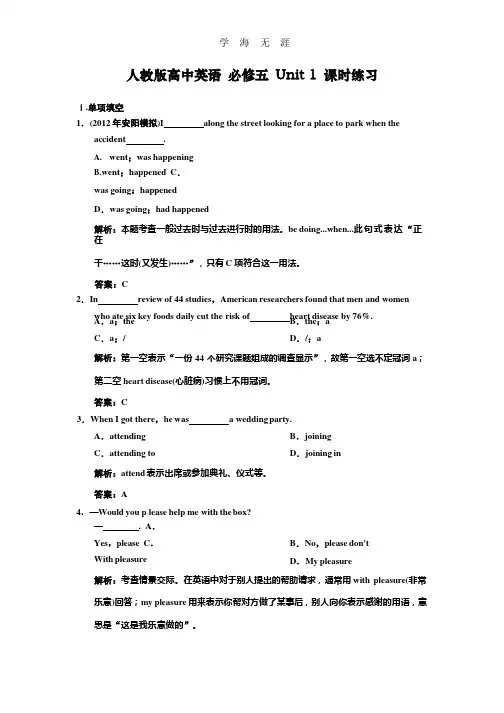
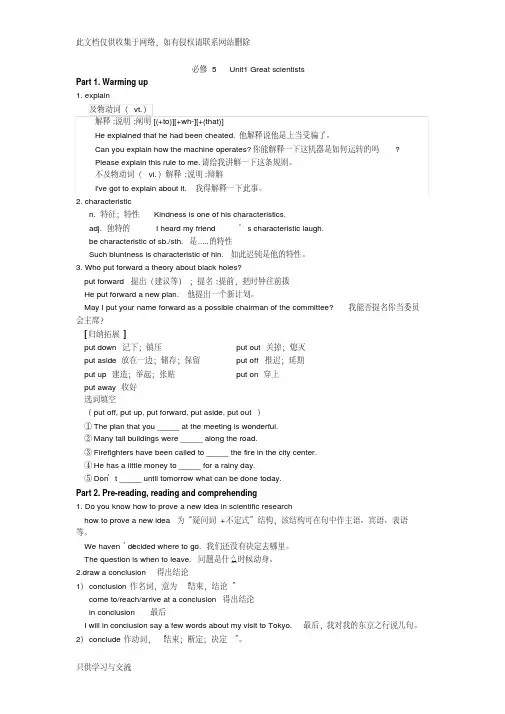
必修 5 Unit1 Great scientistsPart 1. Warming up1.explain及物动词(vt.)解释;说明;阐明[(+to)][+wh-][+(that)]He explained that he had been cheated. 他解释说他是上当受骗了。
Can you explain how the machine operates?你能解释一下这机器是如何运转的吗?Please explain this rule to me.请给我讲解一下这条规则。
不及物动词(vi.)解释;说明;辩解I've got to explain about it. 我得解释一下此事。
2.characteristicn. 特征;特性Kindness is one of his characteristics.adj. 独特的I heard my friend’s characteristic laugh.be characteristic of sb./sth. 是.....的特性Such bluntness is characteristic of hin. 如此迟钝是他的特性。
3. Who put forward a theory about black holes?put forward 提出(建议等);提名;提前,把时钟往前拨He put forward a new plan. 他提出一个新计划。
May I put your name forward as a possible chairman of the committee?我能否提名你当委员会主席?[归纳拓展]put down 记下;镇压put out 关掉;熄灭put aside 放在一边;储存;保留put off 推迟;延期put up 建造;举起;张贴put on 穿上put away 收好选词填空(put off, put up, put forward, put aside, put out)①The plan that you _____ at the meeting is wonderful.②Many tall buildings were _____ along the road.③Firefighters have been called to _____ the fire in the city center.④He has a little money to _____ for a rainy day.⑤Don’t _____ until tomorrow what can be done today.Part 2. Pre-reading, reading and comprehending1. Do you know how to prove a new idea in scientific researchhow to prove a new idea 为“疑问词+不定式”结构,该结构可在句中作主语、宾语、表语等。
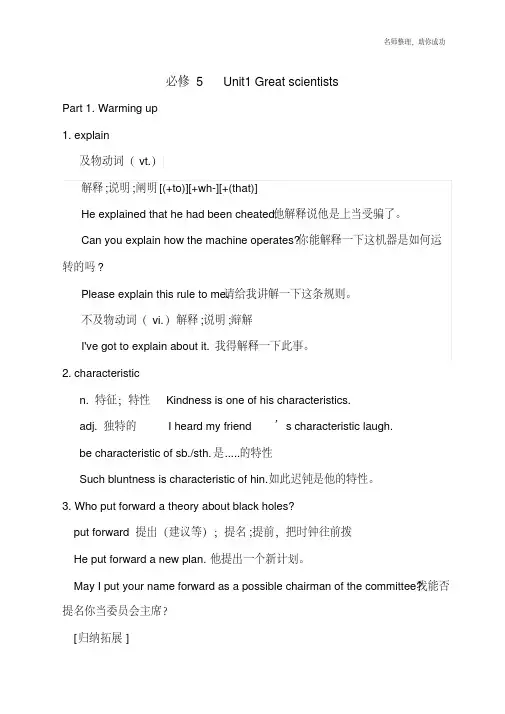
必修5 Unit1 Great scientistsPart 1. Warming up1.explain及物动词(vt.)解释;说明;阐明[(+to)][+wh-][+(that)]He explained that he had been cheated. 他解释说他是上当受骗了。
Can you explain how the machine operates?你能解释一下这机器是如何运转的吗?Please explain this rule to me.请给我讲解一下这条规则。
不及物动词(vi.)解释;说明;辩解I've got to explain about it. 我得解释一下此事。
2.characteristicn. 特征;特性Kindness is one of his characteristics.adj. 独特的I heard my friend’s characteristic laugh.be characteristic of sb./sth. 是.....的特性Such bluntness is characteristic of hin. 如此迟钝是他的特性。
3. Who put forward a theory about black holes?put forward 提出(建议等);提名;提前,把时钟往前拨He put forward a new plan. 他提出一个新计划。
May I put your name forward as a possible chairman of the committee?我能否提名你当委员会主席?[归纳拓展]put down 记下;镇压put out 关掉;熄灭put aside 放在一边;储存;保留put off 推迟;延期put up 建造;举起;张贴put on 穿上put away 收好Part 2. Pre-reading, reading and comprehending1. Do you know how to prove a new idea in scientific researchhow to prove a new idea 为“疑问词+不定式”结构,该结构可在句中作主语、宾语、表语等。
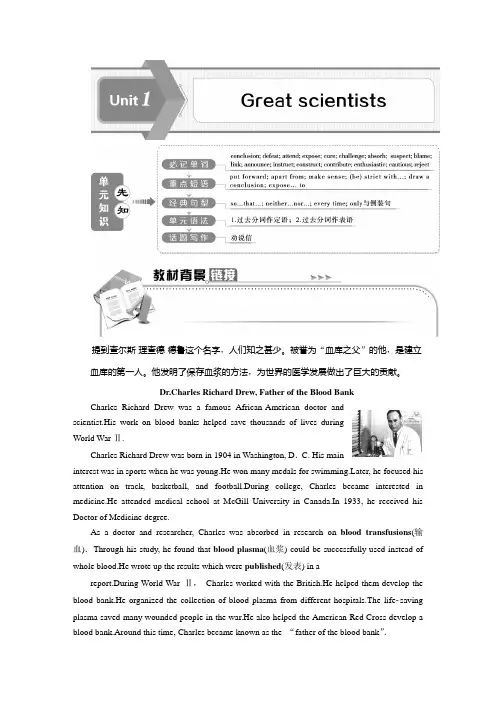
提到查尔斯·理查德·德鲁这个名字,人们知之甚少。
被誉为“血库之父”的他,是建立血库的第一人。
他发明了保存血浆的方法,为世界的医学发展做出了巨大的贡献。
Dr.Charles Richard Drew, Father of the Blood BankCharles Richard Drew was a famous African-American doctor andscientist.His work on blood banks helped save thousands of lives duringWorld War Ⅱ.Charles Richard Drew was born in 1904 in Washington, D.C. His maininterest was in sports when he was young.He won many medals for ter, he focused his attention on track, basketball, and football.During college, Charles became interested in medicine.He attended medical school at McGill University in Canada.In 1933, he received his Doctor of Medicine degree.As a doctor and researcher, Charles was absorbed in research on blood transfusions(输血).Through his study, he found that blood plasma(血浆) could be successfully used instead of whole blood.He wrote up the results which were published(发表) in areport.During World War Ⅱ,Charles worked with the British.He helped them develop the blood bank.He organized the collection of blood plasma from different hospitals.The lifesaving plasma saved many wounded people in the war.He also helped the American Red Cross develop a blood bank.Around this time, Charles became known as the “father of the blood bank”.Charles’life was cut short by a car accident in 1950.However, his legacy(遗产) is still alive and well today.Charles’ name appears on a great number of schools and organizations across the country.In 1981, his photo appeared in the United States Postal Service’s Great Americans stamp series.At Amherst, a beautiful brick house is named in memory of his outstanding achievements.Th e American Red Cross’ Charles Drew Institute in Biomedical Services is also named after him.Section ⅠWarming Up & Reading—Comprehending重点单词写作词汇1.analyse v t.分析2.defeat v t.打败;战胜;使受挫n. 失败3.expert adj. 熟练的;经验或知识丰富的n. 专家;行家4.attend v t.照顾;护理;出席;参加5.physician n.医生;内科医师6.expose v t.暴露;揭露;使曝光7.cure n.治愈;痊愈v t. 治愈;治疗,8.suspect v t.认为;怀疑n. 被怀疑者;嫌疑犯9.severe adj. 严重的;剧烈的;严厉的10.foresee v t.预见;预知11.blame v t.责备;谴责n. 过失;责备12.handle n.柄;把手v t. 处理;操纵13.link v t.& n.连接;联系拓展词汇14.painter n.画家;油漆匠→paint v.绘画;涂→painting n.油画;水彩画15.scientific adj.科学的→science n.科学→scientist n.科学家16.conclude v t.& v i.结束;推断出→conclusion n.结论;结束17.absorb v t.吸收;吸引;使专心→absorbed adj.全神贯注的;一心一意的18.pollute v t.污染;弄脏→pollution n.污染19.announce v t.宣布;通告→announcement n.公告;宣布→announcer n.播音员;宣告者20.challenge n.挑战v t.向……挑战→challenging adj.挑战性的21.certainty n.确信;确实→certain adj.确实的;肯定的→certainly ad v.确定;肯定阅读词汇22.characteristic n.特征;特性23.radium n.镭24.infect v t.传染;感染25.deadly adj. 致命的26.outbreak n.爆发;发作,27.victim n.受害者28.enquiry n.询问29.neighbourhood n.附近;邻近30.pump n.泵;抽水机v t. (用泵)抽(水)31.germ n.微生物;细菌重点短语1.put_forward 提出;推荐2.draw_a_conclusion 得出结论3.expose...to 使显露;暴露4.be_determined_to_do_sth. 决心做某事5.face_a_challenge 面临挑战6.mark...on...在……上把……标出来7.be_to_blame 该受责备;应负责8.link...to... 将……和……联系或连接起来9.look_into 调查10.slow_down 减速;减缓重点句型1.neither...nor...既不……也不……Neither_its_cause_nor_its_cure_was_understood.(人们既不知道它的病源,也不了解它的治愈方法。
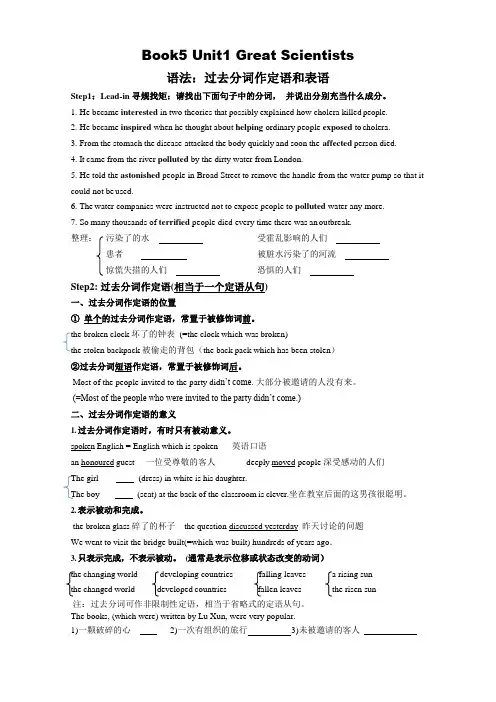
Book5 Unit1 Great Scientists语法:过去分词作定语和表语Step1:Lead-in 寻规找矩:请找出下面句子中的分词,并说出分别充当什么成分。
1.He became interested in two theories that possibly explained how cholera killed people.2.He became inspired when he thought about helping ordinary people exposed to cholera.3.From the stomach the disease attacked the body quickly and soon the affected person died.4.It came from the river polluted by the dirty water from London.5.He told the astonished people in Broad Street to remove the handle from the water pump so that it could not be used.6.The water companies were instructed not to expose people to polluted water any more.7.So many thousands of terrified people died every time there was an outbreak.整理:污染了的水__ _患者___惊慌失措的人们__ _ 受霍乱影响的人们__ _ 被脏水污染了的河流__ _ 恐惧的人们__ _Step2: 过去分词作定语(相当于一个定语从句)一、过去分词作定语的位置①单个的过去分词作定语,常置于被修饰词前。
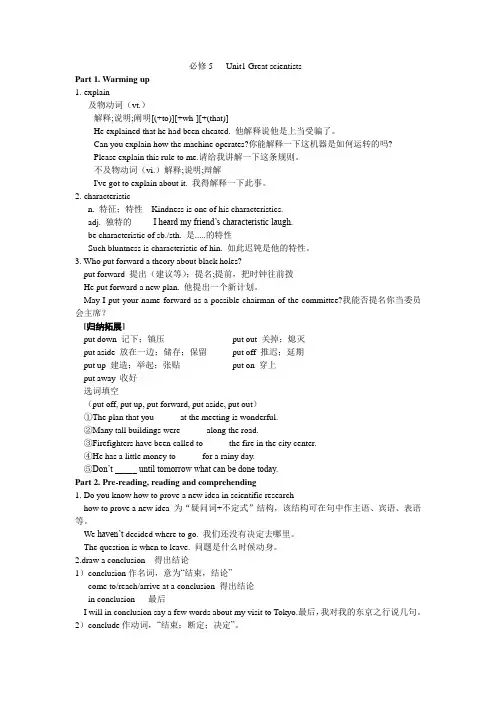
必修5 Unit1 Great scientistsPart 1. Warming up1.explain及物动词(vt.)解释;说明;阐明[(+to)][+wh-][+(that)]He explained that he had been cheated. 他解释说他是上当受骗了。
Can you explain how the machine operates?你能解释一下这机器是如何运转的吗?Please explain this rule to me.请给我讲解一下这条规则。
不及物动词(vi.)解释;说明;辩解I've got to explain about it. 我得解释一下此事。
2.characteristicn. 特征;特性Kindness is one of his characteristics.adj. 独特的I heard my friend’s characteristic laugh.be characteristic of sb./sth. 是.....的特性Such bluntness is characteristic of hin. 如此迟钝是他的特性。
3. Who put forward a theory about black holes?put forward 提出(建议等);提名;提前,把时钟往前拨He put forward a new plan. 他提出一个新计划。
May I put your name forward as a possible chairman of the committee?我能否提名你当委员会主席?[归纳拓展]put down 记下;镇压put out 关掉;熄灭put aside 放在一边;储存;保留put off 推迟;延期put up 建造;举起;张贴put on 穿上put away 收好选词填空(put off, put up, put forward, put aside, put out)①The plan that you _____ at the meeting is wonderful.②Many tall buildings were _____ along the road.③Firefighters have been called to _____ the fire in the city center.④He has a little money to _____ for a rainy day.⑤Don’t _____ until tomorrow what can be done today.Part 2. Pre-reading, reading and comprehending1. Do you know how to prove a new idea in scientific researchhow to prove a new idea 为“疑问词+不定式”结构,该结构可在句中作主语、宾语、表语等。
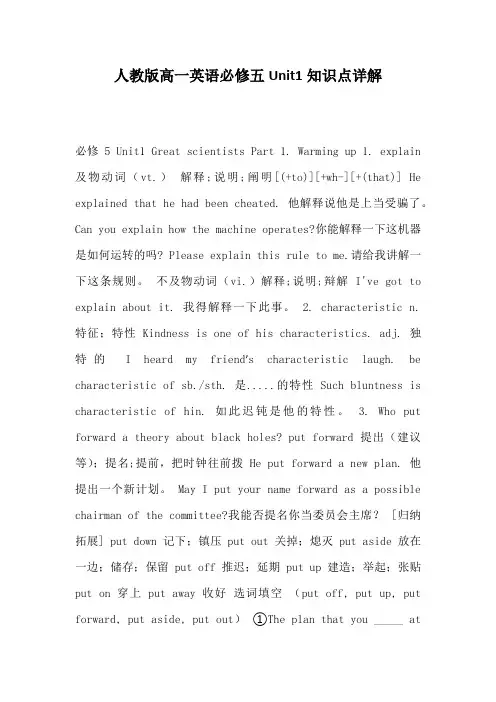
人教版高一英语必修五Unit1知识点详解必修 5 Unit1 Great scientists Part 1. Warming up 1. explain 及物动词(vt.)解释;说明;阐明[(+to)][+wh-][+(that)] He explained that he had been cheated. 他解释说他是上当受骗了。
Can you explain how the machine operates?你能解释一下这机器是如何运转的吗? Please explain this rule to me.请给我讲解一下这条规则。
不及物动词(vi.)解释;说明;辩解 I've got to explain about it. 我得解释一下此事。
2. characteristic n. 特征;特性 Kindness is one of his characteristics. adj. 独特的I heard my friend’s characteristic laugh. be characteristic of sb./sth. 是.....的特性 Such bluntness is characteristic of hin. 如此迟钝是他的特性。
3. Who put forward a theory about black holes? put forward 提出(建议等);提名;提前,把时钟往前拨 He put forward a new plan. 他提出一个新计划。
May I put your name forward as a possible chairman of the committee?我能否提名你当委员会主席? [归纳拓展] put down 记下;镇压 put out 关掉;熄灭 put aside 放在一边;储存;保留 put off 推迟;延期 put up 建造;举起;张贴put on 穿上 put away 收好选词填空(put off, put up, put forward, put aside, put out)①The plan that you _____ atthe meeting is wonderful. ②Many tall buildings were _____ along the road. ③Firefighters have been called to _____ the fire in the city center. ④He has a little money to _____ for a rainy day. ⑤Don’t _____ until tomorrow what can be done today. Part 2. Pre-reading, reading and comprehending 1. Do you know how to prove a new idea in scientific research how to prove a new idea 为“疑问词+不定式”结构,该结构可在句中作主语、宾语、表语等。
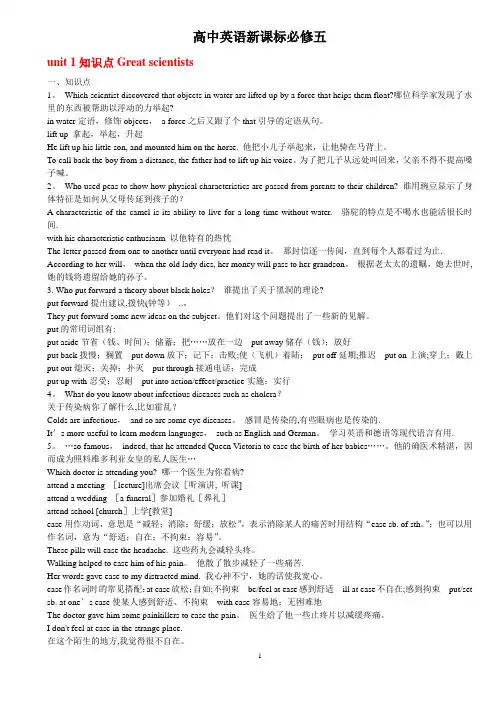
高中英语新课标必修五unit 1知识点Great scientists一、知识点1。
Which scientist discovered that objects in water are lifted up by a force that heips them float?哪位科学家发现了水里的东西被帮助以浮动的力举起?in water定语,修饰objects,a force之后又跟了个that引导的定语从句。
lift up 拿起,举起,升起He lift up his little son, and mounted him on the horse. 他把小儿子举起来,让他骑在马背上。
To call back the boy from a distance, the father had to lift up his voice。
为了把儿子从远处叫回来,父亲不得不提高嗓子喊。
2。
Who used peas to show how physical characteristics are passed from parents to their children? 谁用豌豆显示了身体特征是如何从父母传延到孩子的?A characteristic of the camel is its ability to live for a long time without water.骆驼的特点是不喝水也能活很长时间.with his characteristic enthusiasm 以他特有的热忱The letter passed from one to another until everyone had read it。
那封信逐一传阅,直到每个人都看过为止. According to her will,when the old lady dies, her money will pass to her grandson。
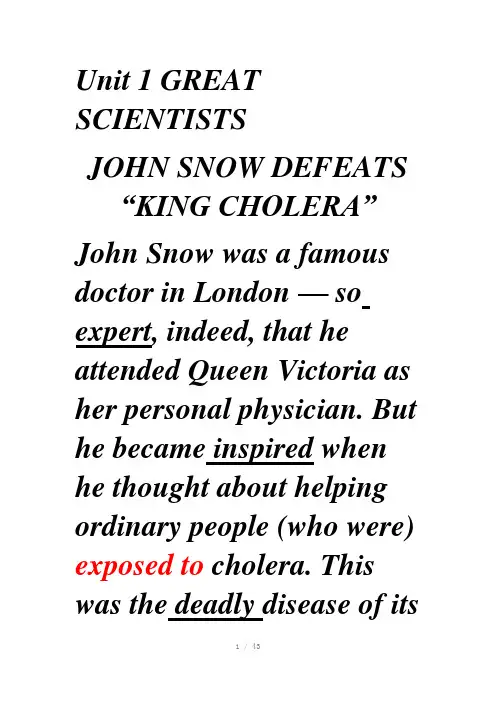
Unit 1 GREAT SCIENTISTSJOHN SNOW DEFEATS“KING CHOLERA”John Snow was a famous doctor in London — so expert, indeed, that he attended Queen Victoria as her personal physician. But he became inspired when he thought about helping ordinary people (who were) exposed to cholera. This was the deadly disease of itsday. Neither its cause nor its cure was understood. So many thousands of terrified people diedevery time there was an outbreak. John Snow wanted to face the challenge and solve this problem. He knew that cholera would never be controlled until its cause was found.(expose:1暴露be exposed to all kinds of weather.经受风吹雨打。
Expose sb to danger 使某人面临危险。
A student who has been exposed to English for some 6 years.接触英语达六年左右的学生。
2.揭露。
Expose a politician’s lies. He has been exposed as a liar.他说谎的行为被揭穿。
)He became interested in two theories(that possibly explained how cholera killed people). The firstsuggested that cholera multiplied in the air, a cloud of dangerous gas floated arounduntil it found its victims. From the stomach the disease quickly attacked the body and soon the affected person died.John Snow suspected that the second theory was correct but he needed evidence. So when another outbreak hit London (There was another outbreak)in 1854, he was ready to begin his enquiry. As the disease spread quickly through poor neighbourhoods, he began to gather information. In two particular streets, the cholera outbreak was so severe that more than 500 people died in ten days. He was determined to find out why.First he marked on a map the exact places(where all the dead people have lived). This gave him a valuable clue about the cause of the disease. Many of the deaths were near the water pump in Broad Street (especially numbers 163738 and 40). He also noticed that some houses (such as 20 and 21 Broad Street and 8 and 9 Cambridge Street) had hadno deaths. He had not foreseen this, so he madefurther investigations. He discovered that these people worked in the pub at 7 Cambridge Street. They had been given free beer and so had not drunk the water from the pump. It seemed that the water was to blame,Next, John Snow looked into the source of the water for these two streets. He found that it came from the river(polluted by the dirty water from London). He immediately told the astonished people in Broad Street to remove the handle from the pump so that it could not be used. Soon afterwards the disease slowed down. He had shown that cholera was spread by germs and not in a cloud of gas.In another part of London, he found supporting evidence from two other deaths(that were linked to the Broad Street outbreak.)A woman,(who had moved away from Broad Street,)liked the water from the pump so much that she had it delivered to her house every day. Both she and her daughter died of cholera after drinking the water.With this extra evidence John Snow was able to announce with certainty that polluted water carried the virus.To prevent this from happening again, John Snow suggested that the source of all the water supplies be examined. The water companies were instructed not to expose people to polluted waterany more. Finally “King Cholera”was defeated.COPERNICUS’REVOLUTIONAYTHEORY Nicolaus Copernicus was frightened and his mind was confused. Although he had tried to ignore them, all his mathematical calculations led to the same conclusion: that the earth was not the centre of thesolar system. Only (if you put the sun there) did the movements of the other planets in the sky make sense. Yet he could not tell anyone about his theory as the powerful Christian Church would have punished him for even suggesting such an idea. They believed God had made the world and for that reason the earth wasspecial and must be the centre of the solar system. (Only: we can succeed only in this way. →Only( in this way) can we succeed.)The problem arose because astronomers had noticed that some planets in the sky seemed to stop, move backward and then go forward in a loop. Others appeared brighter attimes and less bright at others. This was very strange if the earth was the centre of the solar system and all planets went around it. Copernicus had thought long and hard about these problems and tried to find an answer. He had collected observations of the stars and used all his mathematical knowledge to explain them. But only new theory could do that. So between 1510 and 1514 heworked on it, gradually improving his theory until he felt it was complete.In 1514 he showed it privately to his friends. The changes (he made to the old theory) were revolutionary. He placed a fixed sun at the centre of the solar system with the planets going round it and only the moon still going around the earth. He alsosuggested that the earth was spinningas it went around the sun and this explained changes in the movement of the planets and in the brightness of the stars. His friends were enthusiastic and encouraged him to publish his ideas, but Copernicus was cautious. He did not want to be attacked by the Christian Church, so he only published it as helay dying in 1543. (with﹢宾语﹢1)doing2)/done/3)介词短语/4)形容词5)副词6)to do:He slept with the window open (with the light on).The teacher came with a book in his hand (under his arm).With a lot of homeworkto do, I had to stay at home last weekend.With the crowds cheering, the royal party drove into the palace.With signal given, the train left the station.) Certainly he was right to be careful. The Christian Church rejected his theory, saying it was against God’s idea and people (whosupported it) would be attacked. Yet Copernicus’ theory is now the basis (on which all our ideas of the universe are built.) His theory replaced the Christian idea of gravity, (which said things fell to earth because God created the earth as the centre of the universe.) Copernicus showed this was obviously wrong. Now people can see that there is a direct link between his theory and the work ofIsaac Newton, Albert Einstein and Stephen Hawking.(辨析reject,refuse,turn down, decline.Reject:断然拒绝。
【高二学习指导】人教新课标必修五unit1重难点解析一、重点单词用法精解1.characteristicn.特征,特性thechiefcharacteristicofhumanbeingisthattheycanthink.人类主要的特征就是他们可以思索。
2.exposevt.暴露,揭发,曝光(摄影)don’texposethebabytotheburningsun.切勿将小孩暴晒。
注:exposesb/sthto…中的to为介词。
3.defeatvt.&n.打败;战胜;thearmydefeatedtheenemyintheend.军队最终战胜了敌军。
tomsufferedthedefeatintheenglishexamination.汤姆英语考试失利了。
辨析:win的宾语是game,prize等物(不是人);beat和defeat的宾语是人;hit“打一下”;beat“(连续地)打”;strike“重击”。
4.curevt.&n.治好,治疗法thereisnoknowncureforaids.还无治疗艾滋病之法。
itispossibletocurethesickness.治好这种疾病还是可能将的。
辨析:cure“治愈”,强调结果;treat“治疗”,强调动作过程;说curesbofsth.但说treatsbforsth.5.blamevt.责备,归咎于theteacherblamedmeformybeinglateforschoolagain.老师因我又迟到批评了我。
备注:blamesbforsth=blamesthonsb.6.backwardadj.&adv.向后weturnbackward(s)thenrightward(s).我们向后转然后向右转。
搭配:abackwardturn向后转7.concludevt.&vi.完结,总结theteacherconcludedtheclassbyonesentence.老师以一句话总结了这节课。
Unit1 Learning about Language重难点词汇详解1.contribute vt.&vi.捐献;贡献教材原文to contribute做出贡献经典例句①He contributed a lot of good ideas to the discussion.他在这次讨论中提出了很多好的想法。
②We should contribute our youth and talent to the Party and the country.我们应该将我们的青春和才华奉献给党和国家。
③Honesty and hard work contribute to success and happiness.诚实加苦干促成成功和幸福。
④Everyone should make a contribution to protecting the environment.每个人都应当为保护环境做贡献。
⑤He is a regular contributor to children's magazines.他是儿童期刊的定期投稿人。
2.apart from除……之外;此外教材原文Apart from the construction mentioned above, you have also learned the following phrases.除了上面提到的结构,你们还学了以下短语。
经典例句①Apart from the price, the dress doesn't suit me.除价格之外,这件连衣裙也不适合我。
②No one apart from her husband knew about her job.除了她丈夫之外没有人知道她的工作是什么。
③Apart from some spelling mistakes ,your composition is good.除了一些拼写错误之外,你的作文写得不错。
Unit 1 GREAT SCIENTISTSJOHN SNOW DEFEATS“KING CHOLERA”John Snow was a famous doctor in London — so expert, indeed, that he attended Queen Victoria as her personal physician. But he became inspired when he thought about helping ordinary people (who were) exposed to cholera. This was the deadly disease of itsday. Neither its cause nor its cure was understood. So many thousands of terrified people died every time there was an outbreak. John Snow wanted to face the challenge and solve this problem. He knew that cholera would never be controlled until its cause was found.(expose:1暴露be exposed to all kinds of weather.经受风吹雨打。
Expose sb to danger 使某人面临危险。
A student who has been exposed to English for some 6 years.接触英语达六年左右的学生。
2.揭露。
Expose a politician’s lies. He has been exposed as a liar.他说谎的行为被揭穿。
)He became interested in two theories(that possibly explained how cholera killed people). The firstsuggested that cholera multiplied in the air, a cloud of dangerous gas floated around until it found its victims. From the stomach the disease quickly attacked the body and soon the affected person died. John Snow suspected that the second theory was correct but he needed evidence. So when another outbreak hit London (There was anotheroutbreak)in 1854, he was ready to begin his enquiry. As the disease spread quickly through poor neighbourhoods, he began to gather information. In two particular streets, the cholera outbreak was so severe that more than 500 people died in ten days. He was determined to find out why.First he marked on a map the exact places(where allthe dead people have lived). This gave him a valuable clue about the cause of the disease. Many of the deaths were near the water pump in Broad Street (especially numbers 163738 and 40). He also noticed that some houses (such as 20 and 21 Broad Street and 8 and 9 Cambridge Street) had had no deaths. He had not foreseen this, so he made further investigations. Hediscovered that these people worked in the pub at 7 Cambridge Street. They had been given free beer and so had not drunk the water from the pump. It seemed that the water was to blame,Next, John Snow looked into the source of the water for these two streets. He found that it came from the river(polluted by the dirty water from London). Heimmediately told the astonished people in Broad Street to remove the handle from the pump so that it could not be used. Soon afterwards the disease slowed down. He had shown that cholera was spread by germs and not in a cloud of gas.In another part of London, he found supporting evidence from two other deaths(thatwere linked to the Broad Street outbreak.)A woman,(who had moved away from Broad Street,)liked the water from the pump so much that she had it delivered to her house every day. Both she and her daughter died of cholera after drinking the water. With this extra evidence John Snow was able to announce with certaintythat polluted water carried the virus.To prevent this from happening again, John Snow suggested that the source of all the water supplies be examined. The water companies were instructed not to expose people to polluted water any more. Finally “King Cholera” was defeated.COPERNICUS’REVOLUTIONAYTHEORY Nicolaus Copernicus was frightened and his mind was confused. Although he had tried to ignore them, all his mathematical calculations led to the same conclusion: that the earth was not the centre of the solar system. Only (if you put the sun there) did the movements of the otherplanets in the sky make sense. Yet he could not tell anyone about his theory as the powerful Christian Church would have punished him for even suggesting such an idea. They believed God had made the world and for that reason the earth was special and must be the centre of the solar system. (Only: we can succeed only in this way. →Only( in this way) can we succeed.)The problem arose because astronomers had noticed that some planets in the sky seemed to stop, move backward and then go forward in a loop. Others appeared brighter at times and less bright at others. This was very strange if the earth was the centre of the solar systemand all planets went around it.Copernicus had thought long and hard about these problems and tried to find an answer. He had collected observations of the stars and used all his mathematical knowledge to explain them. But only new theory could do that. So between 1510 and 1514 he worked on it, graduallyimproving his theory until he felt it was complete.In 1514 he showed it privately to his friends. The changes (he made to the old theory) were revolutionary. He placed a fixed sun at the centre of the solar system with the planets going round it and only the moon still going around the earth. He also suggested that the earth was spinning as it went around the sun andthis explained changes in the movement of the planets and in the brightness of the stars. His friends were enthusiastic and encouraged him to publish his ideas, but Copernicus was cautious. He did not want to be attacked by the Christian Church, so he only published it as he lay dying in 1543.(with﹢宾语﹢1)doing2)/done/3)介词短语/4)形容词5)副词6)to do:He slept with the window open (with the light on).The teacher came with a book in his hand (under his arm).With a lot of homeworkto do, I had to stay at home last weekend.With the crowds cheering, the royal party drove into the palace.With signal given, the train left the station.) Certainly he was right to be careful. The Christian Church rejected his theory, saying it was against God’s idea and people (who supported it) would be attacked. Yet Copernicus’ theory is now the basis (on which all our ideas of theuniverse are built.) His theory replaced the Christian idea of gravity, (which said things fell to earth because God created the earth as the centre of the universe.) Copernicus showed this was obviously wrong. Now people can see that there is a direct link between his theory and the work of Isaac Newton, Albert Einstein and Stephen Hawking.(辨析reject,refuse,turn down, decline.Reject:断然拒绝。